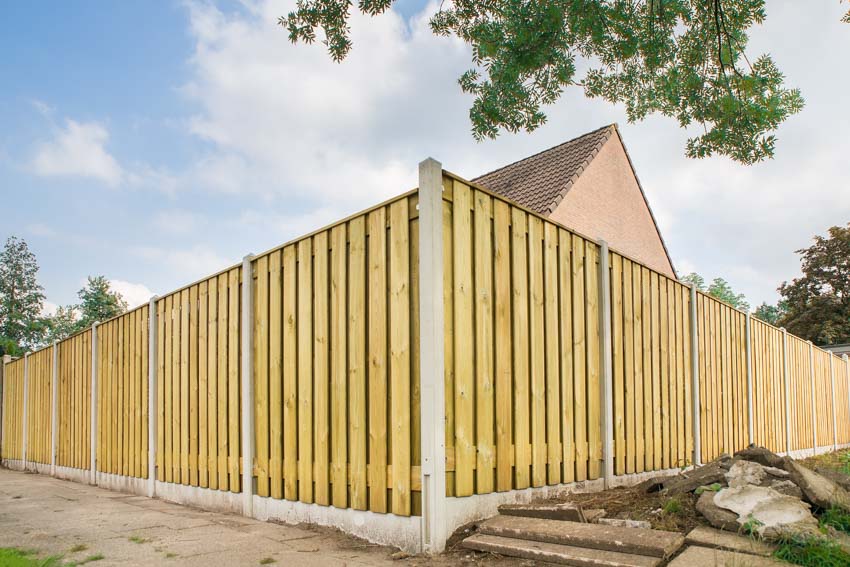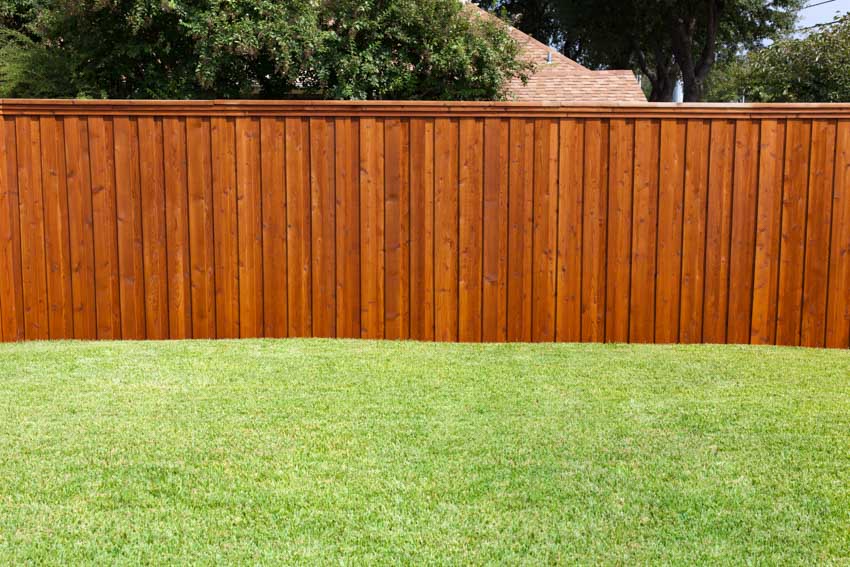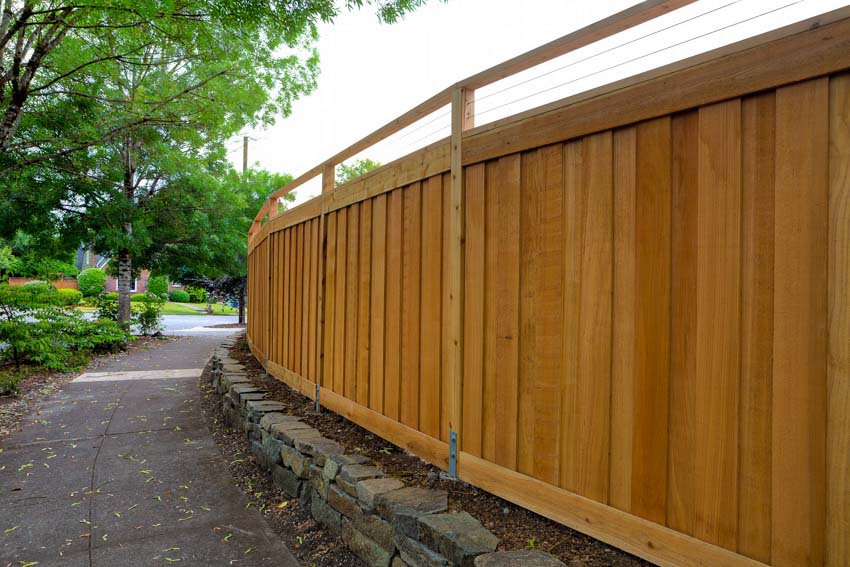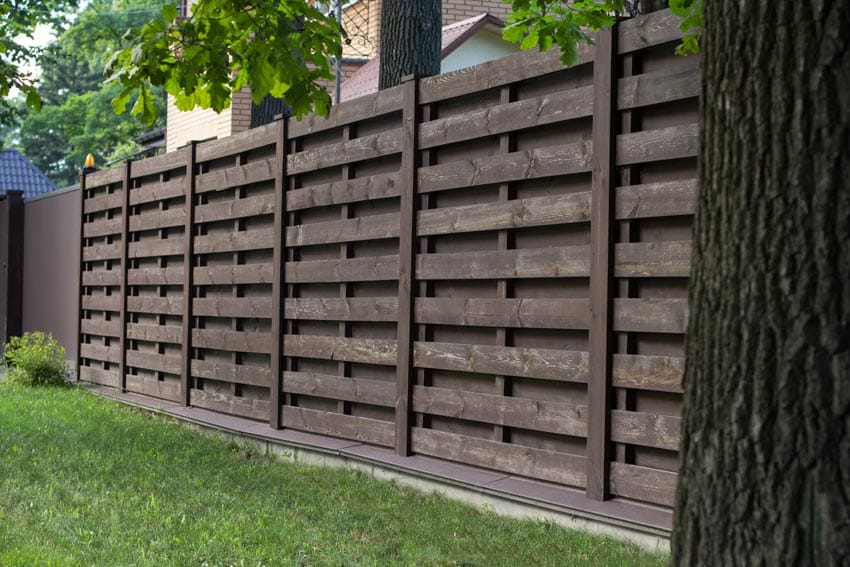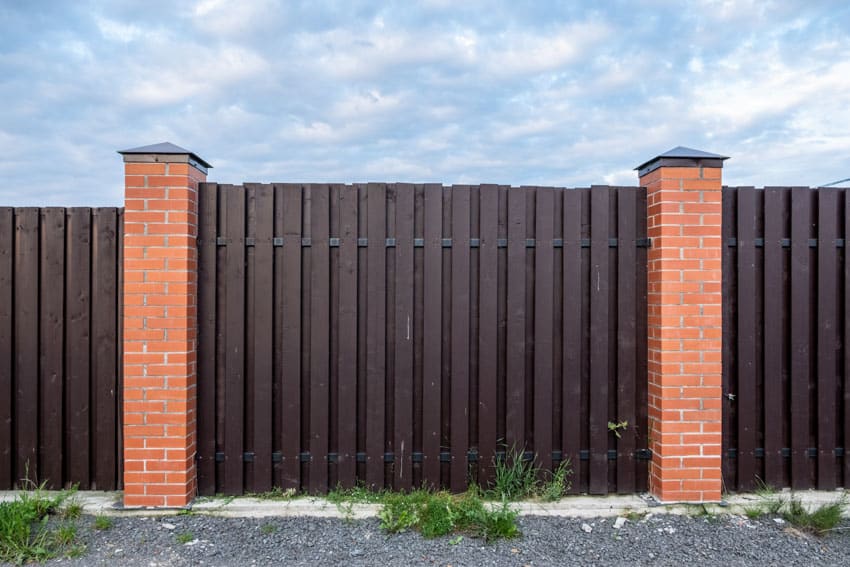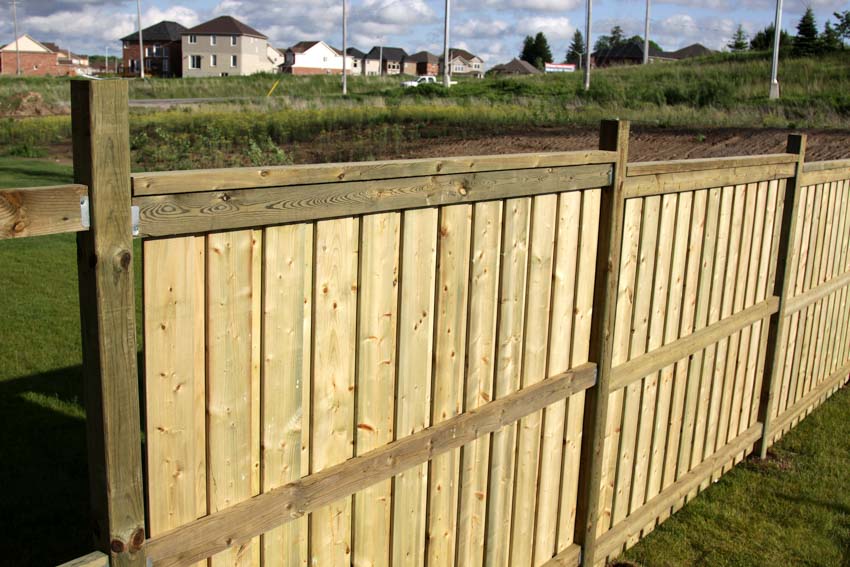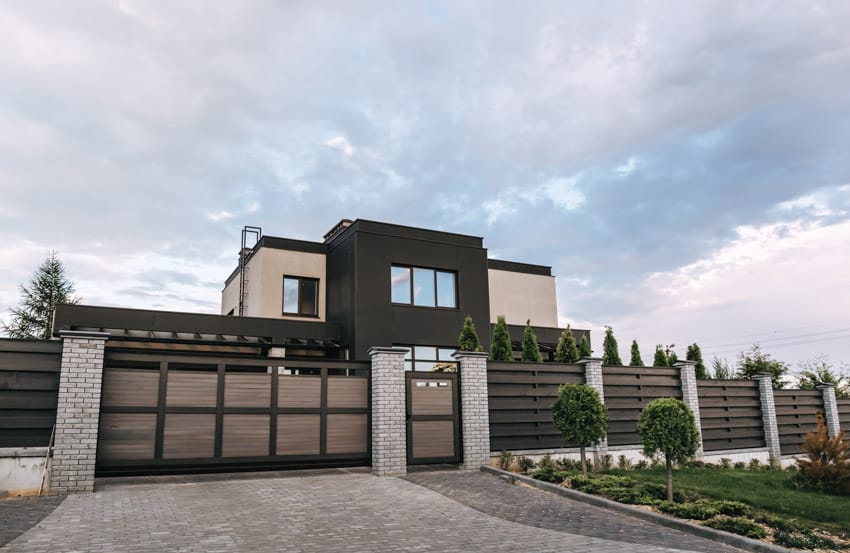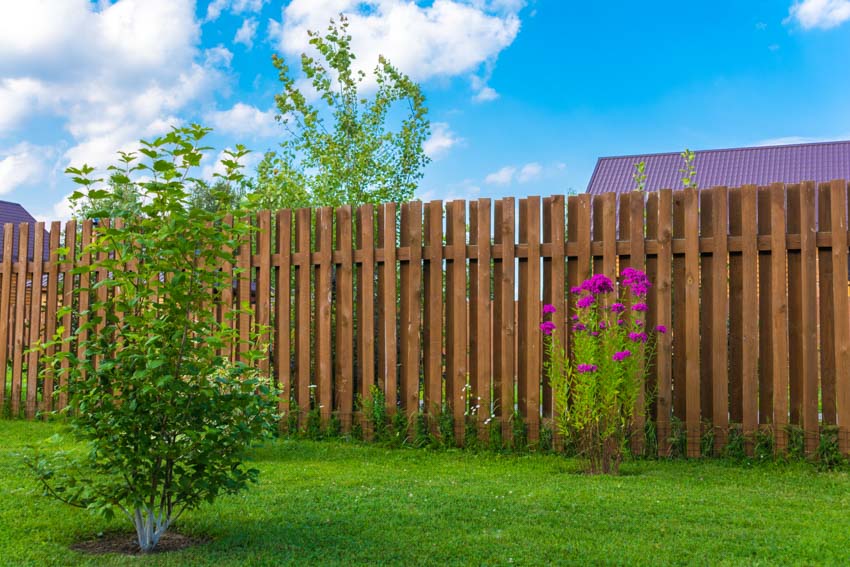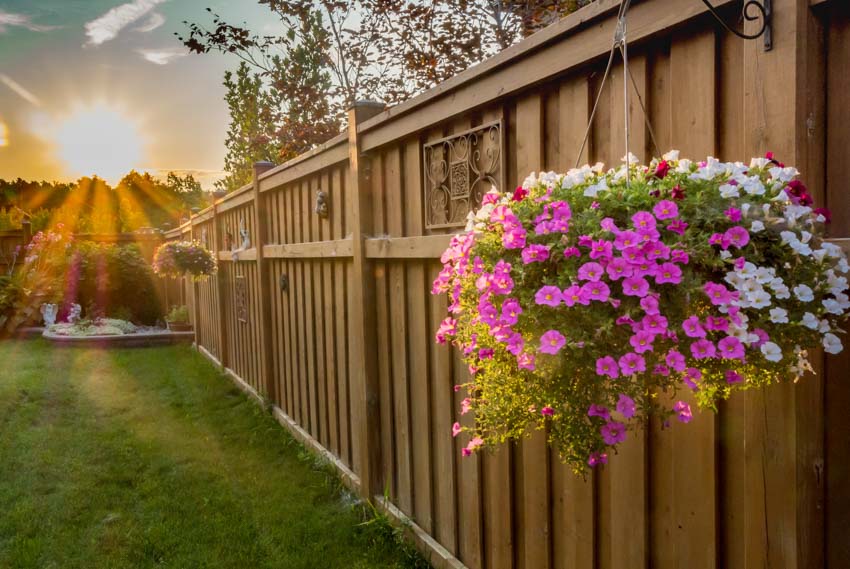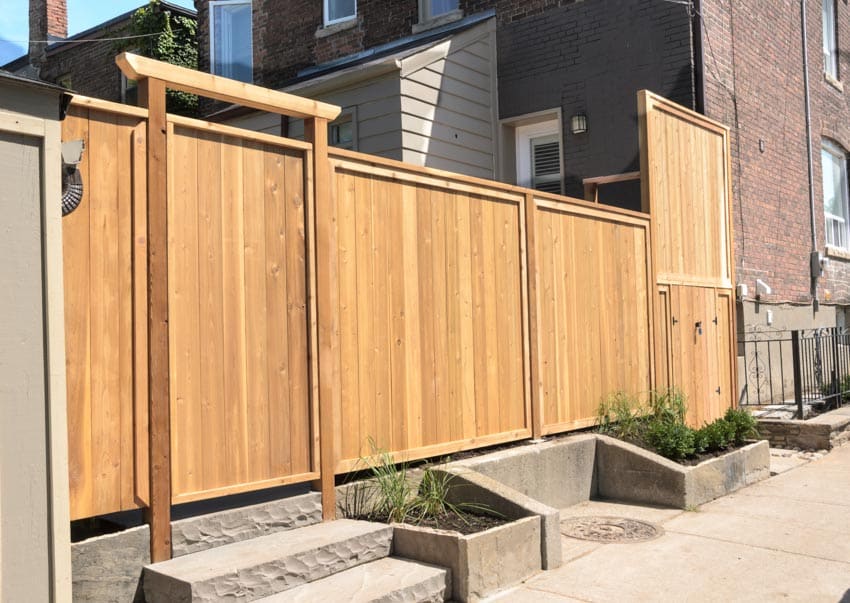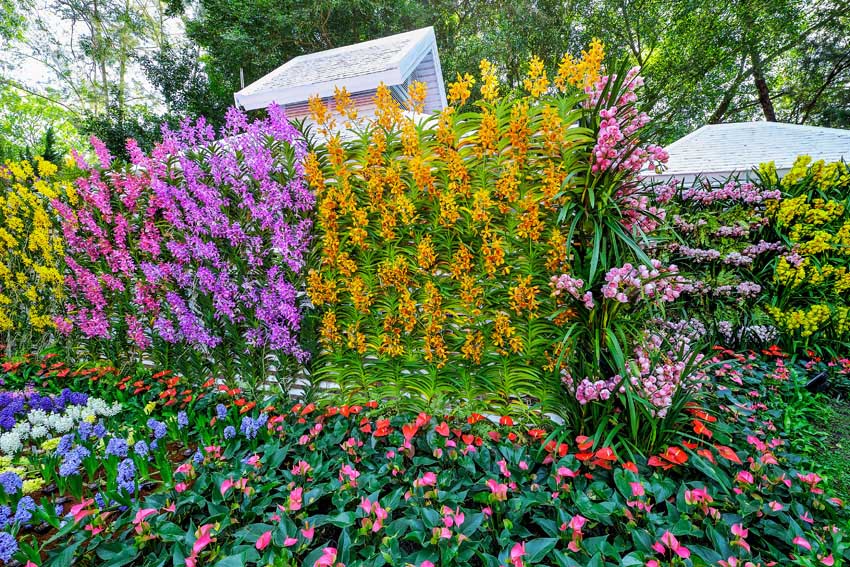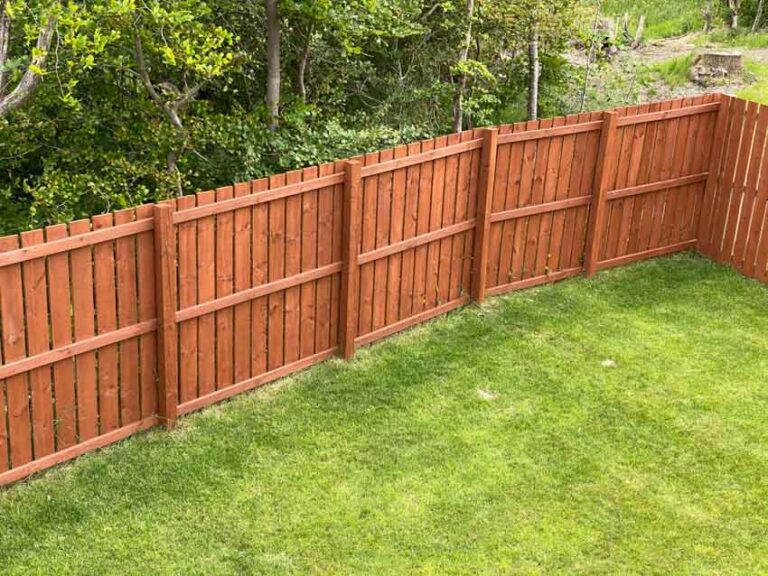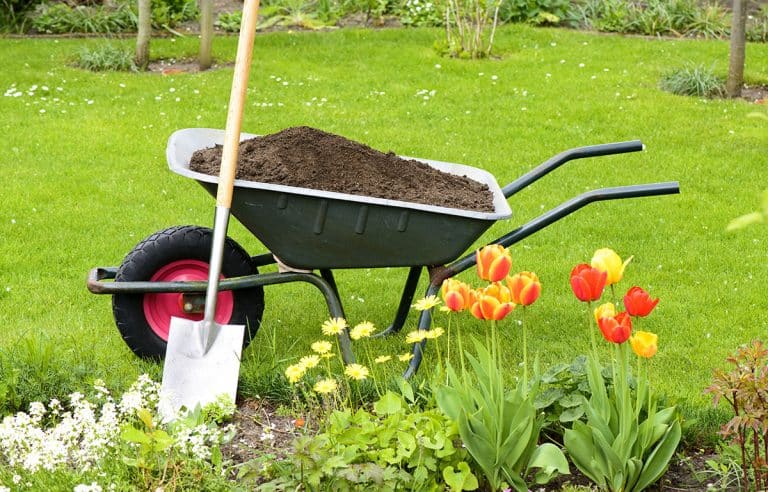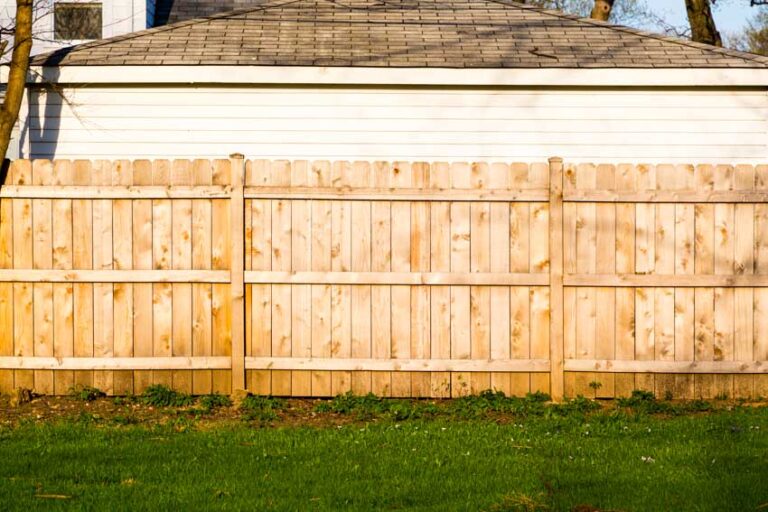Board On Board Wood Fence (9 Types & Designs)
Adding a fence around your yard or garden can offer a lot of benefits. They provide additional security from anyone or anything you don’t want to be able to walk right up. At the same time, this type of fence offers a little extra privacy in obscuring the view of your yard. You have a lot of fencing styles to choose from, but one fencing option that offers both benefits is board-on-board fencing.

What Is a Board-on-Board Fence?
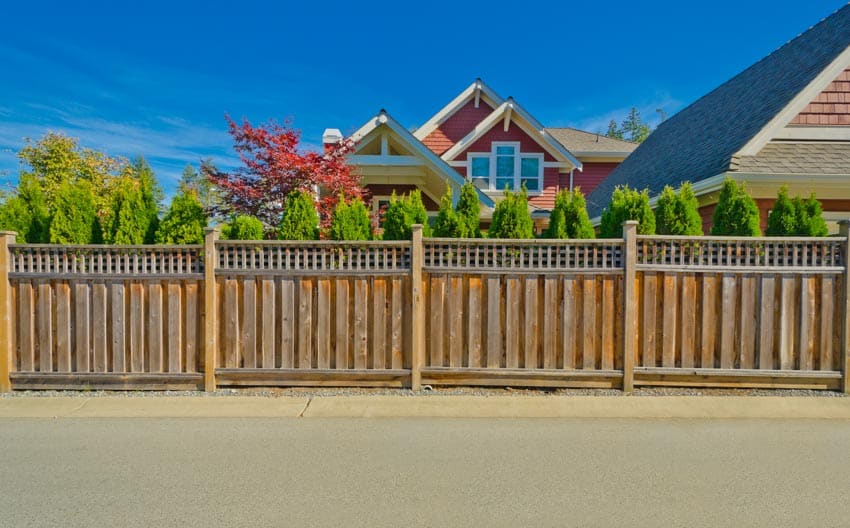
Board-on-board wood fences are a type of fencing that relies on an overlapping pattern. In this pattern, the boards all slightly overlap one another, creating an effect of total privacy on either side of the fence.
To achieve this overlapping pattern, the boards are set in a dual-layer design. Once the rails are set in place, these boards are placed on either side of them in an alternating pattern. This differs from a traditional side-by-side fence in which the vertical pickets are all placed on one side of the railing.
This design is rather solid, thanks to these overlapping panels, offering all the benefits of a privacy fence. The dual-layer design is also helpful in ensuring this style of fence’s longevity and durability.
A board-on-board wood fence comes in a variety of styles and materials as well, allowing plenty of room for customization to fit your needs, wants, and personal tastes. These types of fences can vary in height, too, giving you varying levels of privacy depending on what you need.
Pros and Cons of Board On Board Wood Fences
Pros: Here, we share the pros of a board-on-board wood fence.
• Attractive Design: One of the most obvious benefits of board-on-board fences is their aesthetic appeal.
• Availability of Styles to Choose From: They come in a variety of styles, but their basic design is eye-catching. This is largely thanks to the overlapping design, which adds a bit more of a dynamic appearance than simple side-by-side panels.
• Good for Privacy: This design also makes this type of fencing better for privacy as well. Due to the overlapping design of the panels, it eliminates any potential gaps between the panels that might take away from the privacy you were hoping for. This is particularly helpful in preserving privacy over time.
• Wood Gaps Are Hidden: In a traditional stockade fence, as the wood warps and shows its age, you may see gaps between panels start to grow. Board-on-board fences won’t suffer these gaps with time.
Cons: Here, we share the cons of a board-on-board wood fence.
• Expensive: The biggest downside to board-on-board fencing is that these benefits come at a high monetary cost. This is mostly thanks to the overlapping design of the panels.
• More Fencing Material Needed: Since they are overlapping, it takes more panels to create the fence than if the panels were set edge-to-edge in a flat pattern in a fence of the same size. Since boards overlap by 1” to 1 ½”, you will need as many as 30% more wood pickets.
Board-On-Board Fencing (Types & Designs)
Here, we share the different types and designs of a board-on-board wood fence.
Cedar
Among the best wood for fences using a board-on-board design is cedar. This type of wood is popular in fencing in general for a few reasons. At first sight, you’ll immediately notice the appealing appearance of cedar with its warm, red tones.
Another benefit of a board-on-board wood fence made of cedar is its durability. The material can hold up for up to 25 years but you’ll need to commit to properly maintaining it. Just like any other wood, time will eventually take its toll on cedar, but properly installing and maintaining it will help extend its life as long as possible.
To maintain cedar, you won’t need to go as far as pressure-treating it and generally, it needs less care than most wood types. You can simply wash it with soap and water yearly, but if you want to avoid the color fading, using a pressure washer can help. Refinishing your fence every couple of years is great for the cedar as well.
In addition, you’ll want to keep an eye out for any damage. Addressing issues like a loose or damaged board as soon as they crop up will help increase the longevity of your board-on-board cedar fence.
Pressure Treated Wood
Another wood option you have for your board-on-board fence is pressure-treated wood. Unlike an option like cedar, though, pressure-treated wood can be sourced from a variety of types of wood. It’s a particularly great choice if you want to paint your fence since the material takes to the process well.
Pressure-treated wood is an excellent choice for an outdoor setting for a few reasons, all benefiting your fence. The material is known for its resistance to moisture, insects, fungi, and even fire. In addition, it’s praised for its affordability compared to an option like cedar.
The wood is chemically treated, though. This typically doesn’t cause a problem, but you may not want to use it as fencing around a garden. You’ll need to make sure to stain the wood once a year to maintain its appearance.
One concern with pressure-treated wood is warping or shrinking over time. Using the material in a board-on-board fence style can help mitigate this concern a bit since it allows for overlap in panel placement.
Redwood
Redwood is an excellent choice for board-on-board wood fences, not only for its attractive appearance and tight grain but for its durability as well. Like cedar, this material will last up to 25 years or even longer as a fence when it’s properly installed and maintained.
If you don’t keep up with the maintenance, aside from disrepair, redwood isn’t immune to the effect of graying with age as many types of wood do. As for costs, you can expect the different types of redwood fencing to run at about $7 to $15 per square foot on average for materials.
In a board-on-board fence design, you’ll have to purchase more material than a standard side-by-side fence, leading to a higher average cost for redwood board-on-board fences.
This is more expensive when it comes to common fencing woods but still doesn’t reach the expense of tropical wood. Given that a board-on-board fence is designed to look appealing on both sides, you can use the style to showcase the natural beauty of the cedar.
Vinyl Fencing Material
Not a wood material at all, vinyl fencing is a shorter term for the material used to create it, called polyvinyl chloride. This is often simply shortened to the term PVC. This is a plastic option that offers a lot of benefits.
The biggest benefit of vinyl fencing is its durability. Not only is it a material that isn’t likely to break but you won’t find it attracting fungus or bugs like termites either.
Since you aren’t using a wood product, you don’t have to worry about maintenance steps like staining, finishing, or treating as well. Instead, you just need to clean it with a bit of soap and water.
On the other hand, you will want to work with vinyl carefully in extreme climates. In particular, strong wind, rain, and extreme temperatures will all compromise the integrity of vinyl fencing.
Vinyl fencing tends to come at a higher cost than most wood options, as well. You can expect a cost of about $15 to $30 per square foot of material.
Board-On-Board Fencing Panels
There are a lot of parts to a fence. For instance, you start out by placing posts and pickets. Once you have those in place, you’re ready for the fence panels.
Fence panels are the slats that make up the main body of the fence itself. Depending on the design of the fence, they may be laid horizontally or vertically. In the case of a vertical installation, they may even feature a shaped top to the panels for an added visual touch to the fence.
In board on board wood fences, you’ll need more panels than you would in a traditional stockade fence. This is because rather than laying the panels side-by-side directly, this type of fence uses two layers of panels positioned with an overlap.
Board-On-Board Panels with Top Cap
Top caps on fences are placed over the posts. They’re not an uncommon sight, and they come in a variety of appearances as well. Typically, they’re selected to match or complement the appearance of the fence.
As for colors, manufacturers often stick to neutral or natural colors. These natural colors often include options like green and brown. As for neutral colors, black and white are the most common, but the popularity of white top caps isn’t nearly as high as that of black top caps.
This is because black top caps tend to match more decor schemes and aren’t as likely to show visible wear as early. You have a few options as far as materials go, as well. Some of the most popular include vinyl and wooden top caps.
Both offer many of the same benefits and drawbacks of using the same material in the fence itself. For example, wood top caps are prone to rotting, while vinyl lacks UV resistance, which can lead to fading and cracking as time goes on. For a stronger option, some homeowners turn to plastic resin caps with a higher UV resistance than vinyl plastic.
Dog Ear Paneled Fence
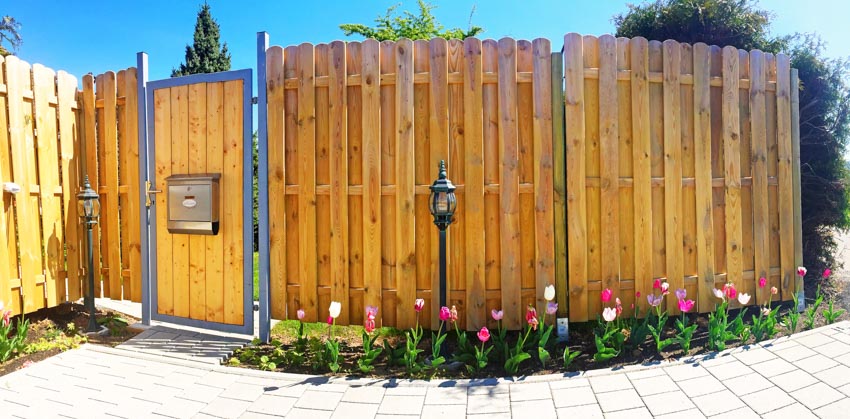
A dog-ear panel features a shaped design, specifically at the top of each board. Instead of a neutral plane finishing off the top of the panels, dog-ear panels have a three-sided top. The end result adds a trapezoid shape rather than a flat plane to the top of your enclosure, giving it a textured, visually dynamic appearance.
The design gets its name from the shape’s resemblance to a dog’s folded ear. All in all, it’s a popular choice to finish off the top of any style of fence – board-on-board style fencing included. The style is more commonly used in wooden fences and can fit both decorative and privacy fences.
Horizontal Panel Fences
The term board-on-board fencing is usually used to describe a style in which the panels are placed vertically. Technically, though, you don’t have to stick by this rule of thumb if you want. Instead, you can opt for a horizontal board-on-board perimeter barrier.
This type of board-on-board barrier uses the same basic template. You’re still going to have a dual-layer enclosure with overlapping panels. The major difference is how the panels are installed. Rather than installing them vertically, they’re installed horizontally, creating an appearance of stacked slats.
Just like vertical board-on-board fences, you get all of the same benefits. You’ll still have privacy, security, and appeal on both sides of the enclosure. It’s a great way to shake up the design for something a bit unique!
Since the slats are placed horizontally, these fences usually have a flat plane to finish off the top of the structure. Because the top of the panels isn’t the top of the fence, horizontal board-on-board fences usually skip out on designs like dog-ear panels.
Board-On-Board Privacy Fence
As we mentioned earlier, board-on-board fences are an excellent choice for several reasons, including the privacy they offer. This is largely thanks to the dual-layer and overlapping features in their design.
In fact, as long as they’re between six and eight feet tall, board-on-board fences are ideal options for homeowners in need of effective privacy fence ideas. These two features help make sure that your enclosure offers full coverage from both sides.
For one, you’re working with two layers of material, offering more coverage right away. With the offset measurements to allow for an overlap, all the usual gaps in a stockade enclosure are covered.
The overlapping design helps to maintain privacy over time as well. Side-by-side panels may start to pull away from one another as the years wear on and the wood warps and shrinks. The overlap of a board-on-board privacy enclosure helps to reduce the gaps that this natural fluctuation in the wood can create.
Overlapping Board Fence Cost
Because board-on-board wood fences have overlapping panels, they come at a great cost. In the end, this design calls for more material than if you were to set the panels edge-to-edge.
For the materials you’ll need to build a board-on-board enclosure, you can expect an average cost of around $10 per square foot.
However, you may find deals as low as $2 per square foot or even as high as $15 per square foot. This cost includes the materials for the fence, but not the tools you’ll need to construct a board-on-board enclosure.
If you opt for a DIY installation, you can save on additional costs. If you’d rather leave the job up to a professional team than trusting your own construction skills, the company will charge by the hour of work.
This can vary depending on where you are and who you work with, but you can expect an installation to cost about $50 per hour on average. Putting this all together, the average board-on-board fence costs between $2,000 to $11,000 in total.
Building a Board-On-Board Style Fence
Before you begin purchasing the materials you need for your new fence, it’s important to begin planning your layout. You may consider using a fence design software program to estimate the materials needed and create a plan. Once you know the amount of materials and supplies needed you can begin building.
To start building any fence, you’ll want to use stakes and twine to map out your enclosure. This is a good time to make sure your lines are straight and give yourself a visual guideline to work with.
Once you have the perimeter staked out, you can start placing posts. Having a post-hole digger handy will make this process much faster and more precise.
If you don’t, you’ll want to create a hole that you can fit a third of your post in. You’ll want to add about six inches of gravel, too to help avoid any drainage problems.
With the posts ready, you can mix your concrete and place the posts. There are two things you’ll want to do for each post. One, make sure to work your post into the wet concrete until it reaches the gravel bottom. Secondly, grab a level to make sure each post is as placed flat as they seems.
After you have your posts set up, you can add your rails. The placement of these rails can vary depending on the exact style you choose, but the top and bottom rails will be about a foot from the top and bottom of the posts. The middle rail is always placed halfway between the top and bottom rails.
The next step is adding pickets. You can start with the pickets on the corner of the fence and then grab your twine again to create a height reference as you place the remaining pickets.
Ideal Spacing Between Boards
To ensure both sides of the enclosure are attractive, board-on-board fences are usually installed in an alternating pattern. When one panel goes on one side, the next panel goes on the other with an overlap to ensure total coverage.
Because of this design, it’s crucial to get the spacing between each board correct to make sure you have the privacy enclosure design you’re striving for. As for the overlap, the boards should run over one another by about an inch. So, you should take this into account when measuring how far boards should be apart from one another on the same side of the railing.
For example, if you were to use 6-inch wide boards, you’d want to put them around 3 ½ inches apart to give them about an inch of overlap on either side. By calculating these measurements before you get started, you can easily install the panels on one side and then the other rather than switching from side to side to simply measure the one-inch overlap.
How Does a Board-On-Board Design Differ from a Shadow Box Fence?
Much like board-on-board fencing, shadow box fencing uses a dual-layer design with overlapping panels. However, a few key differences in their design set them apart from one another.
Primarily, this comes down to how much privacy each one offers. As we’ve covered, board-on-board fences offer as close to total privacy as possible because of the overlapping boards. While shadow box fences have overlapping boards, they’re positioned to offer partial privacy.
Another major difference between the two is cost. Shadow box fences are typically more expensive than a board-on-board alternative for a few reasons. Not only do shadow box fences need more materials, but you often have to rely on a professional installation to accomplish the technique. Shadow box fences often cost up to $22 per foot before adding the cost of labor for installation.
Finally, board-on-board fencing offers more durability than shadow box enclosures. You’ll likely see board-on-board fences last longer thanks to its tightly overlapping design compared to the more open overlap used in shadow box fencing.
Board-On-Board Vs Side By Side Fence
Side-by-side fences are a more traditional style of fencing. These simply place the panels directly next to one another so that their edges touch but don’t overlap. This is responsible for most differences between a side-by-side and a board-on-board enclosure.
Aside from aesthetics, a side-by-side enclosure usually costs less than a board-on-board type. It requires fewer materials because you don’t have to account for an overlap. Instead, each board adds its own width to the total length of the enclosure.
However, board-on-board fences are likely to outperform side-by-side fences in the long run when it comes to durability. This is especially true with wood fences, where the material may warp or change shape over time.
If the panels start to pull away from one another slightly, the effect is much more noticeable in side-by-side fences. In a similar vein, board-on-board fences have deeper posts than average, making them a stronger choice as well.
All in all, board-on-board fences offer a lot of benefits for their cost. They’re known for their lasting durability, an ongoing offer of seclusion, and their visual appeal.
Not to mention, even within board-on-board fences, you have enough options when it comes to materials and design to make your board-on-board fence one of a kind! They make a great choice for anyone looking for a little extra security and privacy!
See more related content in our article about the different types of fences for windy areas on this page.




